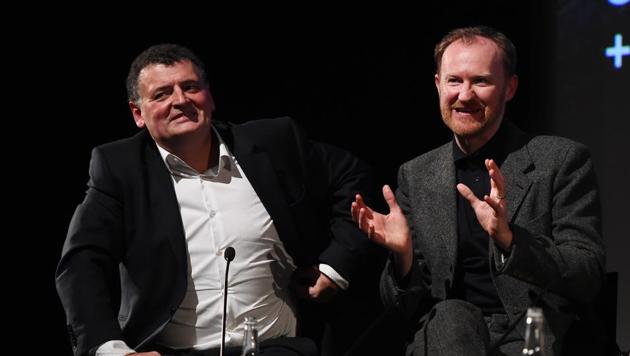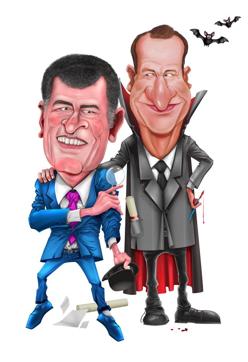The power of two: Steven Moffat and Mark Gattis
The screenwriting duo have made it their business to give modern makeovers to iconic fictional characters from the past. After Sherlock Holmes, it’s time for an upgraded Count Dracula.
By his own admission, writer and producer Steven Moffat is “a wuss for horror”, a fan of Buffy the Vampire Slayer, and a man who doesn’t watch horror films. Some may argue this doesn’t bode well for the new adaptation of Dracula, a character devised by the Irish author Bram Stoker in the 19th century, but fortunately, Moffat’s writing companion is a proper horror geek.

Moffat has reunited with actor and writer Mark Gatiss, to bring back one of the most exciting writing duos in contemporary television. Plus, Gatiss doesn’t just relish horror, he’s even lived in a haunted house.
While doing an ‘Ask Me Anything’ or AMA on Reddit in 2015, Gatiss recounted his stay at a house in Leeds. “All kinds of odd little things started to happen. There was a very strong smell of tobacco smoke. The atmosphere was sort of charged, like a room had been full of people. And then one night I woke up and all the lights were on. And it was the middle of summer, and it was so cold, I could see my breath in the air,” wrote Gatiss, adding that later a medium had visited the house and told him “someone was waiting at the threshold” of the room Gatiss had been using. And, said the medium to Gatiss, “they’re still there.”
The scares in Moffat and Gatiss’s Dracula will give you more goosebumps than Gatiss’s lived experience. Starring Danish actor Claes Bang as Dracula, the three-part show, currently streaming on Netflix, is a reimagining of the classic. The series draws upon many existing legends of Dracula, which is not surprising considering Gatiss did a documentary on Bram Stoker’s Dracula (did you know, for instance, that Stoker’s Dracula could go out in the sun, but couldn’t be photographed or painted?) and a series on the history of horror films.
While this latest retelling has most of the characters from the original, many get a makeover. Perhaps the most dramatic upgrade is the nameless nun in Stoker’s novel who is the atheist nun Agatha Van Helsing in the new series. Played by Dolly Wells, Agatha is a fantastic character and arguably fiercer than Stoker’s Professor Abraham Van Helsing.

Although the story begins in the 19th century, Gatiss and Moffat drag Dracula into the present, as they did with Arthur Conan Doyle’s Sherlock Holmes. While the updated version of Conan Doyle’s Victorian-era detective made Gatiss and Moffat internationally well-known in 2010, by then the two had already garnered a loyal fan following in the UK.
Moffat had first come to prominence with the success of Coupling, a sitcom about six friends that was more Seinfeld than Friends, and was loosely based on Moffat’s own relationship with producer Sue Vertue (she’s the executive producer on Dracula and Sherlock).
Gatiss was part of a sketch comedy team called The League of Gentlemen, which would win the prestigious Perrier award in 1997 at the Edinburgh Fringe Festival. He would later adapt The League of Gentlemen to television, where it would gain a cult following and inspire sketch shows like Little Britain, that used exaggeration to parody and satirise.
Gatiss and Moffat met at a party in the late 1990s and quickly became friends. “We used to get drunk and try and pitch bringing back Doctor Who to any BBC executive we could find in the room,” Gatiss has said, about the early years of his relationship with Moffat. The now-iconic Doctor Who — about a mysterious Time Lord who travels through time and space in what looks like a police box from the 1950s but is actually a cutting-edge time machine called the Tardis — had gone off the air in 1989. Gatiss and Moffat would be among the writers who penned episodes for the first season when the show was revived in 2005.
In 2010, Moffat became the showrunner for Doctor Who and Gatiss joined the writing team, ushering in a golden era for the series.
The duo came up with the idea of modernising Sherlock Holmes while travelling by train from London to Cardiff, where Doctor Who was filmed. Both men had been fans of Conan Doyle’s stories since childhood and it struck them that the TV versions emphasised Sherlock’s Victoriana whereas the whole point of Conan Doyle’s Sherlock was that he was almost uncomfortably modern for his times. So they developed an edgy, contemporary Sherlock who used nicotine patches instead of pipes and described himself as “a high-functioning sociopath”. The first series aired in 2010, and turned Moffat, Gatiss and Benedict Cumberbatch, who played Sherlock, into international celebrities.
Netflix would have been hoping that Dracula would take a page out of Moffat and Gatiss’s Sherlock, especially since horror has seen a powerful revival on the big screen. Films like Get Out, Us, Hereditary and A Quiet Place have seen both intelligent writing and box office returns. However, enjoyable as it may be for fans of the genre, Gatiss and Moffat’s Dracula often feels muddled. The strength of their Dracula is that it is deeply meditative as it weaves in tantalising concepts like blood being a conduit for memory and experience, as well as the idea of how shame can influence a person’s sense of self.
Ironically, the main reason Dracula’s arrival into the 21st century doesn’t feel like an epiphany is that Gatiss and Moffat’s Sherlock has been there, done that. Still, you can’t deny that it’s great fun to watch him stare with rapt fascination at a TV screen. Admittedly, the internet may not be breaking to explain the series’ ending the way it did when Sherlock seemingly plunged to his death, but Gatiss and Moffat can rest in peace (temporarily) for having given Dracula a new lease of life.






